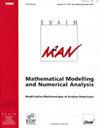A flux globalization based well-balanced path-conservative central-upwind scheme for the shallow water flows in channels
IF 1.9
3区 数学
Q2 Mathematics
Esaim-Mathematical Modelling and Numerical Analysis-Modelisation Mathematique et Analyse Numerique
Pub Date : 2023-01-29
DOI:10.1051/m2an/2023009
引用次数: 1
Abstract
We develop a flux globalization based well-balanced (WB) path-conservative central-upwind (PCCU) scheme for the one-dimensional shallow water flows in channels. Challenges in developing numerical methods for the studied system are mainly related to the presence of nonconservative terms modeling the flow when the channel width and bottom topography are discontinuous. We use the path-conservative technique to treat these nonconservative product terms and implement this technique within the flux globalization framework, for which the friction and aforementioned nonconservative terms are incorporated into the global flux: This results in a quasi-conservative system, which is numerically solved using the Riemann-problem-solver-free central-upwind scheme. The WB property of the resulting scheme (that is, its ability to exactly preserve both still- and moving-water equilibria at the discrete level) is ensured by performing piecewise linear reconstruction for the equilibrium variables rather than the conservative variables, and then evaluating the global flux using the obtained point values of the equilibrium quantities. The robustness and excellent performance of the proposed flux globalization based WB PCCU scheme are demonstrated in several numerical examples with both continuous and discontinuous channel width and bottom topography. In these examples, we clearly demonstrate the advantage of the proposed scheme over its simpler counterparts.基于通量全球化的河道浅水流动平衡路径保守中心逆风方案
我们提出了一种基于通量全球化的通道内一维浅水流动的平衡路径保守中心逆风方案。研究系统的数值方法面临的挑战主要是当通道宽度和底部地形不连续时,存在非保守项来模拟流动。我们使用路径保守技术来处理这些非保守积项,并在通量全球化框架内实现该技术,其中摩擦和上述非保守项被纳入到全局通量中:这导致了一个准保守系统,该系统使用riemann -问题求解器-无中心逆风格式进行数值求解。通过对平衡变量(而不是保守变量)进行分段线性重建,然后使用获得的平衡点的点值评估全局通量,确保了所得到方案的WB特性(即在离散水平上精确保持静水和动水平衡的能力)。在连续和不连续通道宽度和底部地形条件下的数值算例中,验证了基于磁通全球化的WB pcccu方案的鲁棒性和优异的性能。在这些示例中,我们清楚地展示了所提出方案相对于其简单对应方案的优势。
本文章由计算机程序翻译,如有差异,请以英文原文为准。
求助全文
约1分钟内获得全文
求助全文
来源期刊

CiteScore
2.70
自引率
5.30%
发文量
27
审稿时长
6-12 weeks
期刊介绍:
M2AN publishes original research papers of high scientific quality in two areas: Mathematical Modelling, and Numerical Analysis. Mathematical Modelling comprises the development and study of a mathematical formulation of a problem. Numerical Analysis comprises the formulation and study of a numerical approximation or solution approach to a mathematically formulated problem.
Papers should be of interest to researchers and practitioners that value both rigorous theoretical analysis and solid evidence of computational relevance.
 求助内容:
求助内容: 应助结果提醒方式:
应助结果提醒方式:


